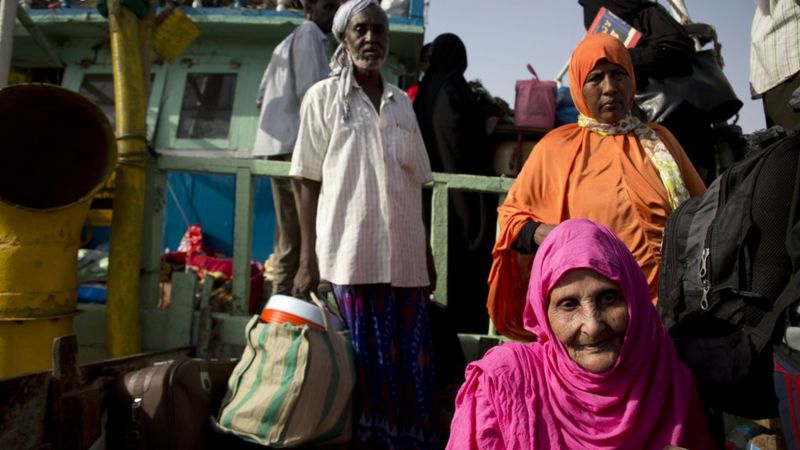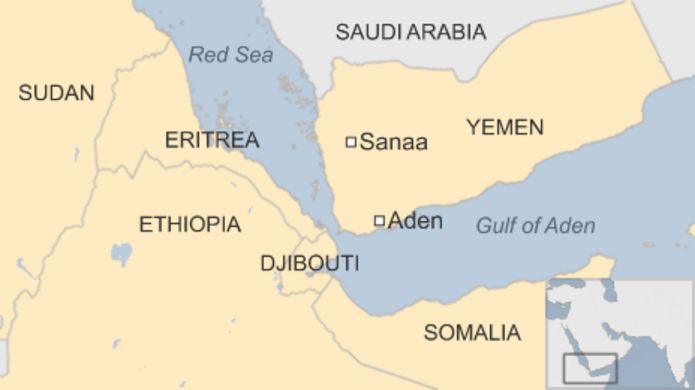-
30 October 2015
- From the section Middle East


"Refugees and migrants", a recent report by the International Organization for Migration (IOM) noted, "arrive after many hours at sea often traumatised and exhausted, with little or no personal belonging, and in urgent need of food, water and emergency healthcare."
This, however, was not about what is happening on the shores of Mediterranean countries, but to do with the thousands of people fleeing in another direction from the fighting in Yemen, and landing on the Horn of Africa.
The United Nations Refugee Agency, UNHCR, estimates that since Yemen's conflict began in March, some 70,000 people have fled to Somalia, Djibouti, Sudan and Ethiopia.
Most have been making the perilous journey by boat across the Gulf of Aden or the Red Sea.
In pictures: The Somalis fleeing home from Yemen
Even the shortest crossing - the strait between Yemen and Djibouti - is traditionally called "the gates of grief" because of its notoriously choppy waters.
Then there is the added problem that none of those countries in the Horn of Africa are really equipped to absorb large numbers of refugees.
Perhaps the most striking thing about this particular refugee crisis is that many of those fleeing Yemen originally went there to get away from problems in their homeland.
Before it descended into violence, Yemen was a host country to 250,000 Somalis. They had originally fled the civil war in Somalia in the 1990s and had crossed the sea in search of safety and work.
Now a substantial number of them are retracing their steps back to Somalia because it is more attractive than staying in an even worse war-torn country.

The irony is not lost on Nicoletta Giordano, Chief of Mission for the IOM in the Yemeni capital, Sanaa.
"We have a paradoxical situation," she says. "These are refugees who would have originally been smuggled into Yemen. But now we have 26,000 Somalis who are returning home."
This presents huge logistical problems for the Somali government, which is not used to dealing with a refugee influx - in fact, rather the reverse.
A recent UN report pinpointed the biggest problems in trying to reintegrate the returning Somalis: "Widespread conflict and political strife [in Somalia] have crippled essential infrastructure and more than three-quarters of the population lack access to healthcare, proper sanitation and safe drinking water."
In an attempt to prepare, a delegation of Somali officials is visiting Yemen soon to try and ascertain whether more of their nationals will be expecting refuge in the coming months.
Djibouti may be more stable than Somalia but it still faces huge challenges in dealing with refugees.
It is thought around 24,000 have arrived in this tiny country in the last few months - around half of them are Yemenis.
The UN is forecasting a total of 36,000 refugees may have arrived in Djibouti by the end of 2016 if the situation in Yemen continues to deteriorate.
The impact of so many people on such as small country is tangible, says Nicoletta Giordano.
"The Djiboutians have managed as best they could and a refugee camp has been set up at Obock but it's very hostile terrain - the weather is harsh and there are desert conditions."

As well as sandstorms and 50C heat, the residents of the camp at Obock have to contend with no electricity and shortages of drinkable water.
There is also no surgeon there and a midwife was only recently recruited.
Indeed, life is so harsh in Obock that many Yemenis have decided they want to avoid at all costs going anywhere near it.
Aid agencies fear that means many refugees are not registering with the authorities and may be putting themselves and their children into even more risky situations as a result.
For seven months now the fighting in Yemen has raged. Aside from civilian casualties, the prospect of famine and the lack of economic opportunities are added reasons to flee the country.
Winter weather and the blockades on Yemen's ports may mean the numbers trying to cross the Gulf of Aden temporarily subside.
But the UN's forecasts suggest that in a year's time there could be 200,000 refugees in the Horn of Africa - a part of the world not used to seeing an immigration influx.